Categories
Subjects
Authors
Artists
Venues
Locations
Calendar
Filter
Done
November 9, 2023 – Review
Meredith Monk’s “Calling”
Patrick Langley
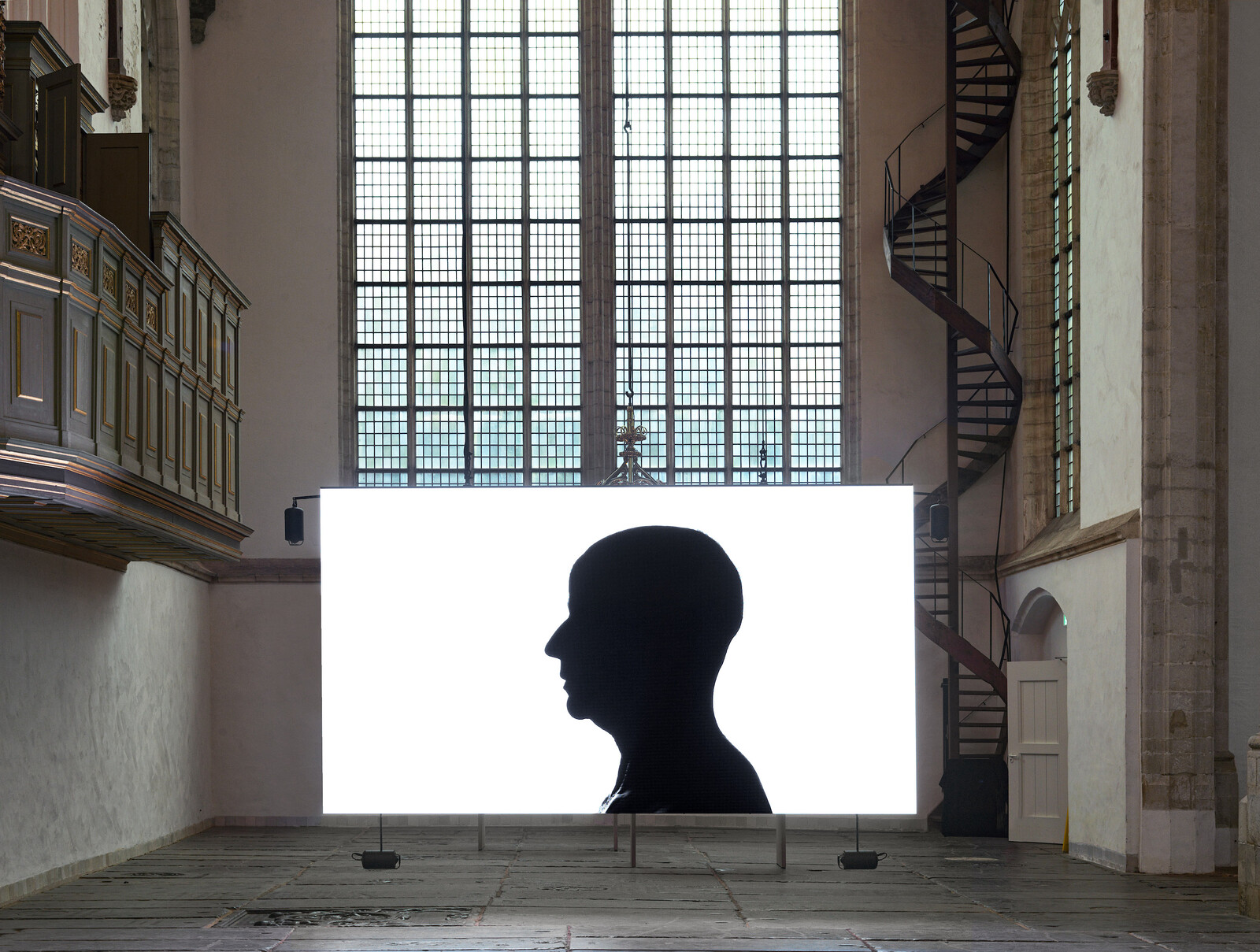
Oude Kerk is a fittingly resonant venue for Meredith Monk’s first—long overdue—retrospective in Europe. This massive thirteenth-century church houses highlights from a polymathic six-decade career that respond to (and echo in) its cavernous nave, with its vaulted wooden ceilings and looming pulpits, its high choir and chapels. To visitors (such as myself) who have only previously encountered Monk’s work via recordings, “Calling,” curated by Beatrix Ruf of the Hartwig Art Foundation, is a revelation. It brings together hypnotic video installations, sculptures, and archival material, yet the result is cohesive, not cacophonous. Each work has space to breathe. Together, they form a harmonious whole.
Several pieces have been revised or reimagined for this show. Amsterdam Archaeology (2023), an iteration of a work first shown in 1998 and the first viewers see upon entering, is one example: a red ziggurat for the display of objects donated by city residents and dipped in beeswax (or “Beuys wax,” as it risks being known in art contexts). These yellowish, translucent cauls point to the union, evident across this exhibition, of industrious and protective instincts. Monk has for decades sought the holistic union of art and healing.
Installations housed in freestanding (and judiciously soundproofed) rooms extend …
July 25, 2023 – Review
“Substitutes”
Eliel Jones

In light of the ongoing conservative backlash against legislative advances for trans rights in Spain, the UK, and Germany, trans visibility remains paradoxically both a requirement for survival and the greatest threat to trans people’s safety. In a first for the artist-run space W139, which for its forty-four years has focused on the production and presentation of new work, a recent exhibition combined historical and contemporary artworks to create a dialogue between past and present experiences of bodily and gender autonomy. “Substitutes” brought together artists who have subjected their bodies to abstractions, disguises, and transformations to find ways to be both present and absent, visible and invisible. At stake is a desire to refuse the logics that demand proof or validity of one’s existence, and to fight back against requirements that are deemed necessary for the recognizing of unruly bodies as legitimate.
Johannes Büttner’s sculptures of loaves of bread pierced with flesh-tunnel holes were hung on the wall and propped on shelves at the entrance and in the gallery’s reading room. Recalling the literal and symbolic body of Christ, the works invoke St. Thomas the Apostle’s insistence on probing Christ’s flesh—not satisfied with seeing and smelling his wounds—to satisfy his …
December 4, 2019 – Review
Charl Landvreugd’s “Movt. Nr. 10: Ososma”
Jonas Staal
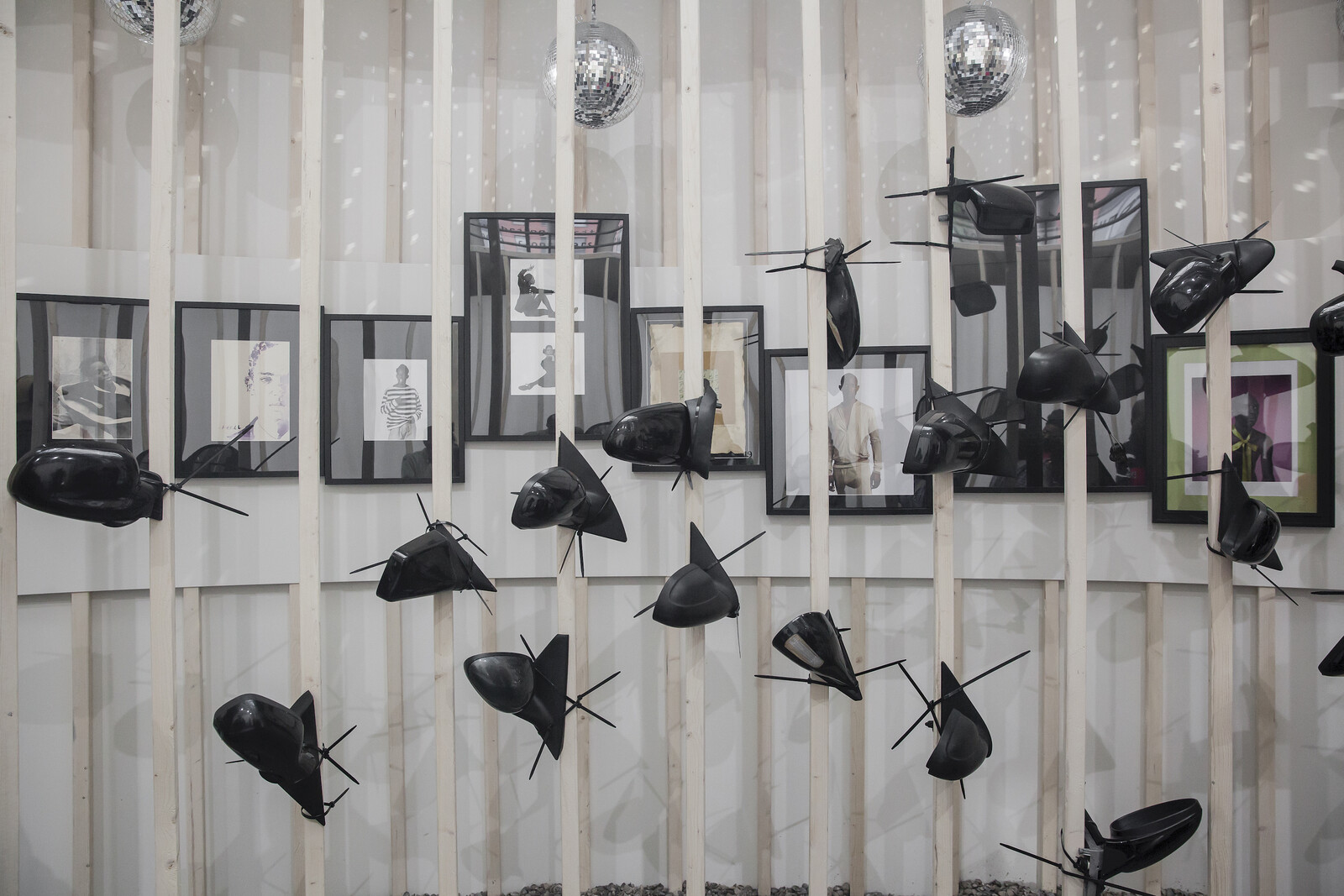
The crunch of seashells breaking underfoot heightens my awareness as I navigate a labyrinth of narrow passages connecting a series of 12 elegant pavilions of varying size. These tall structures, constructed from slim wooden beams, create transparency at one moment and evoke entrapment the next. Sometimes the shells form paths; other times, entry is provided by solid, sleek black walkways. Templates have been used to spray-paint names on a pillar of each pavilion: Athina. Paramaribo. Bruxelles. Milano. Qahira. Rotterdam. Displayed inside them are videos, sculptures, photographs, and drawings.
This is Movt. Nr. 10: Ososma (2019) by Charl Landvreugd. Installed in an empty office building under the premises of CBK Zuidoost, it is both an installation and an exhibition environment featuring an overview of artworks and the periods in which they were created—Landvreugd calls them “movements”—that cross his diverse work as an artist, curator, academic researcher, and leading nightclub organizer in Rotterdam in the 1990s. In the Sranan Tongo language (also known as Surinamese) ososma describes the home that is not one’s own house; a space of relational intimacy and belonging that goes beyond individual property. It suggests how the personal and the common connect in Landvreugd’s work. Each pavilion is …
June 4, 2018 – Review
Stefan Tcherepnin’s “The Mad Masters”
Tom Morton
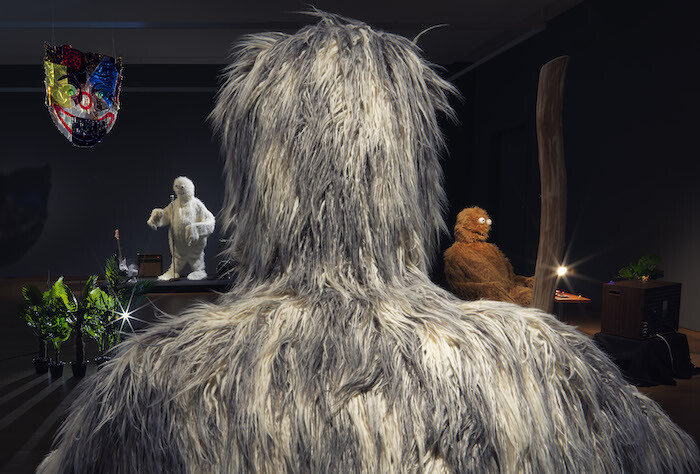
It’s hard to think of another Muppet, or any other fictional character, with so streamlined a motivation as the Cookie Monster. Debuting in the kids’ TV show Sesame Street in 1969, this bug-eyed, blue-furred humanoid has spent almost five decades in the relentless pursuit of sugary biscuits, to the exclusion of all else. Notably, the Cookie Monster never actually eats the cookies he crams so voraciously into the dry, felt cavern of his perpetually hungry mouth. Lacking an esophagus, his tragic fate is to chew, but never swallow. Every bite he takes turns to dust, and then spills from his lips. An avatar of appetite, and perhaps of addiction, the Cookie Monster cannot be satiated. He could munch through every cookie on earth and still never experience the giddy high of a sugar rush.
“The Mad Masters,” Stefan Tcherepnin’s solo show at the Stedelijk Museum, appears to ask what would become of this Muppet if he were to attempt to put aside his monomaniacal focus on baked comestibles and search for meaning elsewhere. Entering the gallery space, the viewer encounters four spot-lit sculptural dioramas, in which a series of Cookie Monster–like creatures are displayed in the manner of taxidermied animals in …
February 17, 2017 – Review
“Where do we go from here?”
Vivian Ziherl
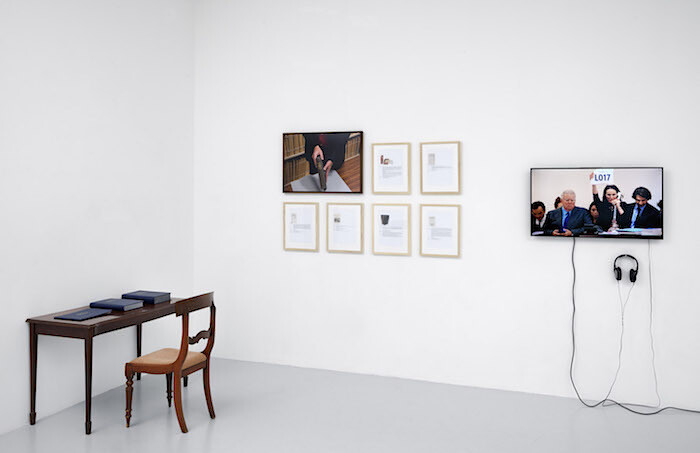
As 2017 opens there is a sense that all bets are off—that it is time to roll the dice and keep a hand open to all possibilities. Perhaps this is all the more so in the Netherlands—in many ways the closest of the EU countries to Britain and perhaps facing its own democractic crisis with a fractious election ahead in mid-March. In a sense this is both the mood and the motive behind a new joint venture by six Amsterdam art galleries and their opening project, titled “Where do we go from here?” As far as gallery experiments go, the basic premise of trading in the art commodity remains unaffected. Nevertheless, within these limits something quite bold is taking place. This joint venture tries out a new, collectivized form of trading, possibly marking a turn towards locality within the art market and the cultural climate more broadly.
The project takes the form of a synchronized exhibition, with works selected from the galleries’ represented artists and arranged by invited curator Alessandro Vincentelli (Curator of Exhibitions and Research, BALTIC Centre for Contemporary Art, Gateshead). Hot on the heels of the evermore successful Amsterdam Art Weekend in November, “Where do we go from here?” …
May 27, 2015 – Review
Renzo Martens and the Institute for Human Activities’ "A New Settlement"
Vivian Ziherl
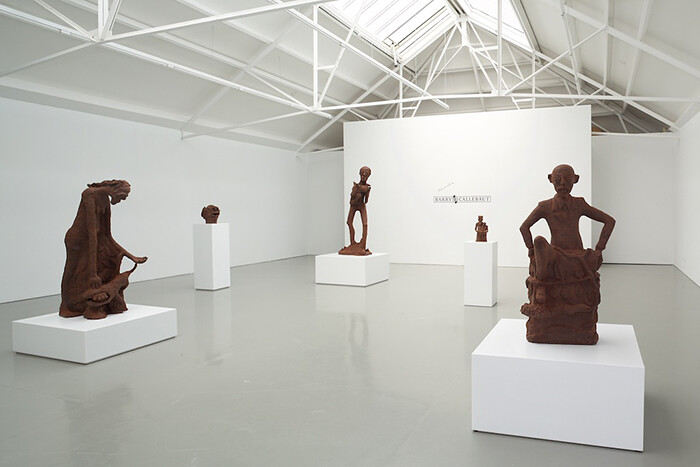
“The missionary went on to talk about the Holy Trinity. At the end of it Okonkwo was fully convinced that the man was mad. He shrugged his shoulders and went away to tap his afternoon palm-wine.” So begins the tragic encounter between the fictional Igbo Chief Okonkwo and the religious men who are the harbingers of colonial power to his region of British Nigeria, as told in Chinua Achebe’s novel Things Fall Apart (1958). The tale portrays, like no other, the foundational role of missionaries in statist imperialism. Here, the religious re-ordering of family, knowledge, and moral worlds is marked out as the true devastation of colonialism, enacting a destruction that exceeds that of imperial firepower.
It is just such a missionary figure that Dutch artist Renzo Martens has fashioned himself as over the past half-decade, most recently with his collective project the Institute for Human Activities, and the exhibition “A New Settlement” at Galerie Fons Welters in Amsterdam. Across six large chocolate sculptures, two small chocolate-sculpture editions, three videos, roughly a dozen photos, and other accoutrements, the “new message” of Martens’s “new settlement” is an evangelism of cultural capital. The claim is that gentrification—as the true product of art—may offer …
January 7, 2015 – Review
Amalia Pica’s "One Thing after Another"
Judith Vrancken
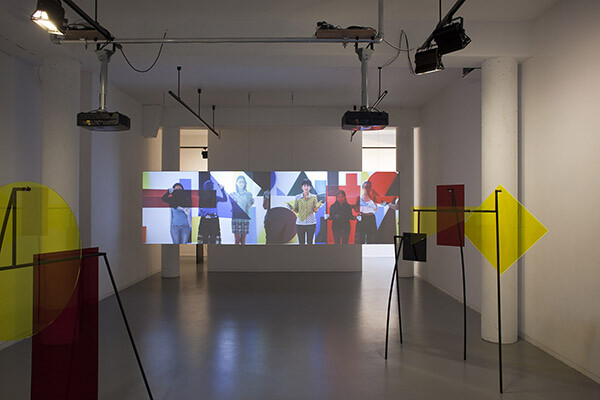
Twenty-first century communication has dramatically changed the way information reaches us. Popular interpretations of knowledge and history seem to do so without historical consciousness and self-reflexivity. Rather than playing with the structure of history, Amalia Pica, in her solo show at Stigter van Doesburg, “One Thing after Another,” concerns herself with the underpinning structure of the structure. She rejects the finality of the object or image, and broadens it from a singular, formal focus to a multifaceted perspective.
The exhibition is a continuation of a project that the London-based Argentinian artist began at the Museo Tamayo in Mexico City in the summer of 2013. Next to some colorful Plexiglas sculptures and pastel-colored prints in the smaller rooms, the show’s focal point is the large installation A∩B∩C∩A∩B∩C (2014), which consists of two Plexiglas sculptures and a two-channel video projection. The sculptures, entitled Maremila and Remoromi (both 2014), are a variety of metal structures holding colored geometrical shapes in saturated blue, red, and yellow. They further Pica’s research on the Venn diagram and the set theory it illustrates, which describes the logical, mathematical relationships of inclusion and exclusion, developed by logician and philosopher John Venn (1834–1923). Under the 1976–1983 military dictatorship in Argentina, …
March 27, 2014 – Review
“Semiotics of the Kitchen. What Happened After”
Stefan Heidenreich
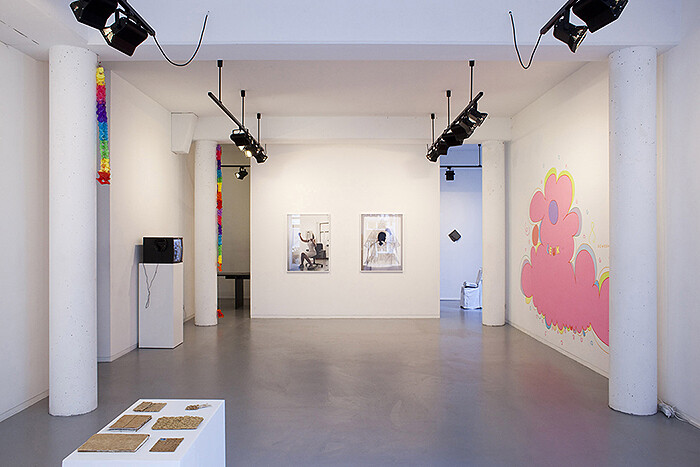
When a speech act contradicts what is said, this is called a performative contradiction. In the mid-1970s, the fight for women’s rights found itself in an inconsistency of this kind, when the general logic of gender construction was cast into doubt. By mapping a useless alphabetical order onto kitchen tools, Martha Rosler’s early video performance Semiotics of the Kitchen (1975) points precisely to this shift from a grammar of signs to a post-structuralist awareness of signifiers being unstable and dynamic. As much as Rosler’s performance stakes out a critical and ironic position towards semiotics—translating and subverting it with supposedly “female” everyday practices—its message is by no means limited to feminist issues. Semiotics was the newly contested theoretical terrain between structuralism and post-structuralism, with the sign and the distinction of signifiers at its core.
But a lot has happened in theory, as much as in art, since 1975: the rise of postcolonialism as well as affective, bodily, post-human, and queer perspectives on theories of gender, just to name a few. This is not to say that this exhibition directly addresses feminism, or even feminist discourses. Rather, this multi-generational group show at Stigter van Doesburg captures the subtle and ironic attitude of Rosler’s …
May 21, 2013 – Review
Gabriel Lester’s “The Secret Life of Cities”
Judith Vrancken
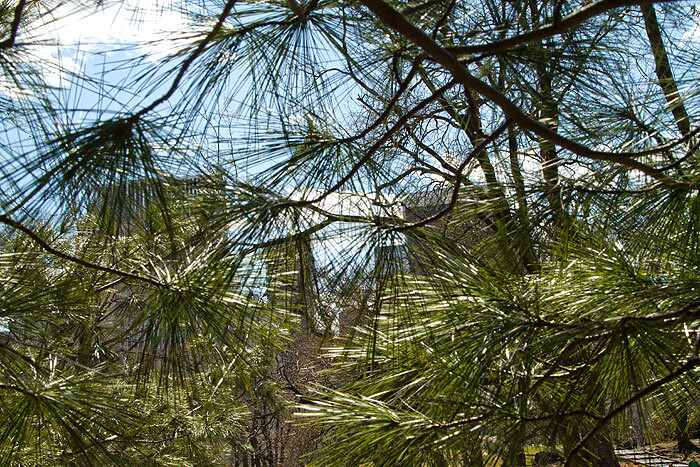
The lust to be a “totalizing eye” immediately sprung to mind when walking into Gabriel Lester’s “The Secret Life of Cities.” It’s one of the key notions expressed in Michel de Certeau’s chapter “Walking in the City” that “the fiction of knowledge is related to [the] lust to be a viewpoint and nothing more.” But as de Certeau’s title suggests, he prefers walking in the city whereas Lester apparently enjoys the hidden refuge of its shrubbery. Taken in Shanghai, New York, Sharjah, and Dubai, Lester’s images are all are shot in the midst of city park bushes. Despite the great distinctions between these metropolises, Lester’s photographs leave the cities to an uncertain anonymity, showing no signs of exceptional cultural identity. In the photographs—seven in total and named in a variation on the show’s title (for example, The Cities of Secret Lives)—the cityscapes rise in high rectangular and jagged lines above the occasionally exotic looking thicket. City soundtracks from the video projection on view in another part of the space penetrate the gallery’s front room so that it cleverly creates a sense of three-dimensionality when taking in the photographs.
The eponymous two-channel video installation consists of two screens opposing each other. A …
May 7, 2013 – Review
Ryan Gander’s “Once upon a Bicycle, not so long ago”
Arnisa Zeqo
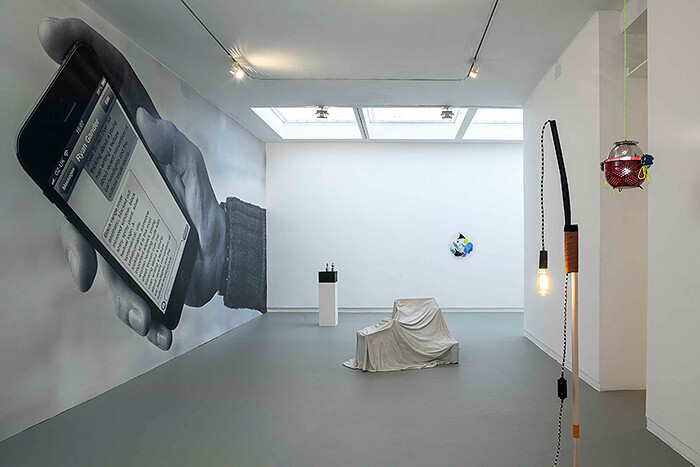
Black-and-white photo wallpaper depicting a gargantuan hand holding an iPhone with two text message bubbles visually dominates Ryan Gander’s show at Annet Gelink in Amsterdam. With the imperative title Be Prepared (2013) the stage is set for potential. I learn that the text displayed on the phone describes a probable artwork the artist thought of making while at a party. The first message reads like an absurdist title to an overtly simple sculpture, which looks like a person wearing a bed sheet over their head: “sheet thrown over her thinking about a young man writing a lecture about recent reinvention of car headlights and the cultural implications…” While the second message builds, like an exquisite corpse, on the visual details not of the artwork itself, but of the setting and (“importantly,” the artist tells us) of the viewer: “Black range rover aesthetic, blacked out mirrored window, black shiny spray paint, silver textual logo, A–Symmetrical, use unfathomable, someone looking at it is the most important aspect, young woman reclining nude with sheet thrown over her thinking about a young man writing a lecture about recent reinvention of car headlights and the cultural implications…” Forget about her “reclining nude,” forget about …
March 8, 2012 – Review
Ursula Mayer’s "Gonda"
Maaike Lauwaert
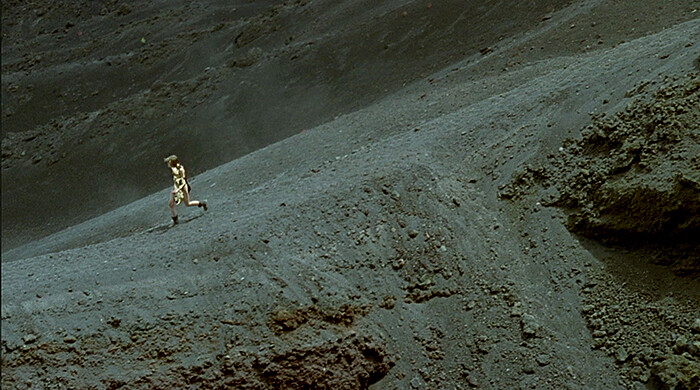
Book blurbs often say things like “unputdownable” or “you want to start rereading the book as soon as you’ve finished it.” The film Gonda (2012) by Ursula Mayer (1970, born in Austria, lives and works in London) has this same compelling and luring quality. As soon as her 30-minute film is over, you want to watch it again. There’s so much there you feel you didn’t quite get. The flow of images is seductive and in combination with the voice-over, the movie is sometimes stirring and exciting, sometimes soothing and calming. And somehow nothing makes sense if you approach the film rationally. There’s a certain desperation, even panic to some of the things the female voice says: “No, it’s not mine. I don’t understand how it ended up in my basket” or “It’s just that I don’t like to be touched” or stronger even, “My death would have nothing to offer me.” Is she a frigid kleptomaniac on the verge of suicide?
Gonda starts with a tall, skinny woman running over the hills: not pastoral, lush, green hills but rather volcano-like, post-apocalyptic, dusty hills. Then a jump shot to an abstract image of colored stripes, and then an Egyptian cat figurine, …
December 9, 2011 – Review
Wilfredo Prieto’s “The Emperor’s New Clothes”
Maaike Lauwaert
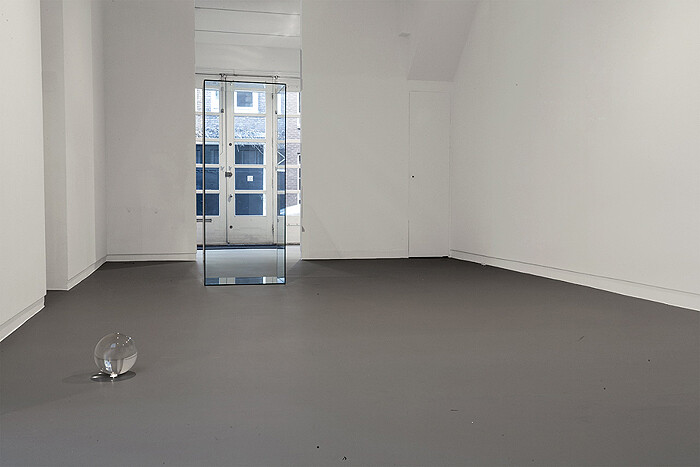
The title of Wilfredo Prieto’s solo show at Annet Gelink Gallery in Amsterdam is as witty as it is tricky. “The Emperor’s New Clothes” takes its name from the well-known 19th-century tale by Hans Christian Andersen on vanity, cunning, and the willing suspension of disbelief, a tale about a narcissistic emperor who is more concerned about his looks than the welfare of his kingdom. One day he is visited by two travelling tailors who offer to make him a magical suit from the most beautiful fabric that is—and this is the crux of the fable—invisible to the stupid. He falls for it, and so do his ministers, the lot of them afraid of being labeled “stupid,” leading in the end to a naked emperor parading the streets.
Prieto likes paradoxes: his show at MARCO, Spain, earlier this year, was based on a tale, penned by the 14th century scholastic French philosopher Jean Buridan, called “Buridan’s ass” about the donkey who perished because he couldn’t chose between a pail of water and the bundle of hay. But “The Emperor’s New Clothes” is far more complex. With hardly anything to see in the gallery, we wonder who we are framed to be: the …
September 27, 2011 – Review
Falke Pisano’s "The Body in Crisis (Distance, Repetition, and Representation)"
Stefaan Vervoort
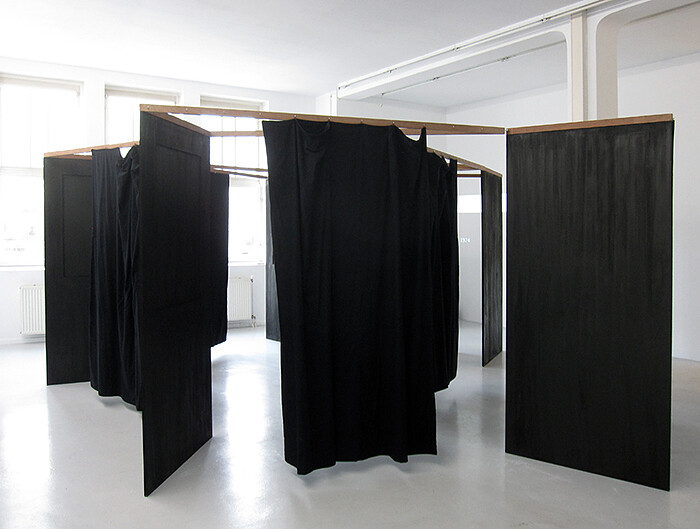
Informed by the rather upsetting constellation that “the body is under full attack,” Falke Pisano’s installation at Amsterdam’s Ellen de Bruijne Projects continues along the path set out by her series of works entitled “Figures of Speech” (2005-2010). With figuration now appended to the video lecture-cum-abstract sculpture format, the work’s objective, however, basically remains the same: that of reiterating an act of speech through a sculptural construct, while simultaneously demonstrating the ineffectiveness and futility of this endeavor. In this case, the juxtaposition of Pisano’s trademark didactical projection with a room-wide twisted chain of black screens does the trick. While the video is a mishmash of historical trivia and abstract reasoning—interrupted by the occasional image and diagram—Pisano’s dark paravents mutely occupy the gallery. Guided through them by the artist’s monotone voice, a phenomenological presence is made to resonate within these walls—yet, obviously, full alignment between the spoken word and sculpture is never attained. The work’s alleged “repetition as reoccurrence or sameness” is inevitably obscured by the opacity of the sculpture and projected images respectively, stuck in the quagmire of a neo-Deleuzian utopia from the very beginning. While Pisano promises to transpose the abstract object into the concrete realm of language, this …
July 27, 2011 – Review
Björn Dahlem’s "The Unknown"
Tyler Coburn
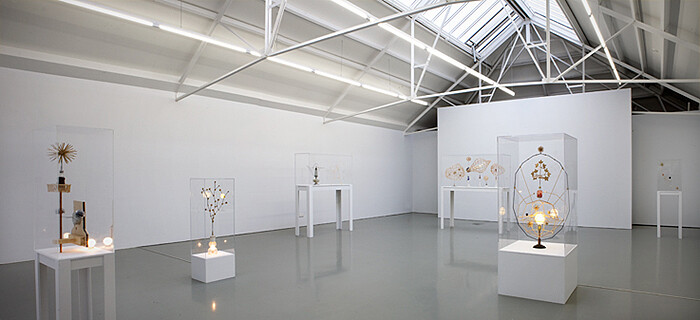
The past month brought another turn to the space race, as the closure of NASA’s cash-strapped, shuttle program made more room for Chinese, Indian, Russian, and even commercial enterprise. With twenty-nine private companies presently vying for Google’s $30 million, Lunar X prize, we are well on the verge of the next wave of invention—and an unprecedented scale of speculation.
Such a reinvigorated, cosmic drive may account for why Björn Dahlem’s current exhibition at Fons Welters feels decidedly out-of-step. Contrary to its titular claim, “The Unknown” puts Dahlem’s practice in the well-trodden line of polymaths like Johannes Müller, Immanuel Kant, Johannes Kepler, and even Aristotle, who, in their respective ways, proposed hybrid models of existence that drew from disciplines like science, mathematics, philosophy, religion, and psychology. Dahlem reprises this figure as an amateurish bricoleur, tinkering away with found objects, wood, and metal tubing on model-size sculptures that take their names from the astronomical lexicon, yet are neither strictly illustrative in form nor, as with a Leonardo, propositionally functional designs. Rather, these works endeavor to constellate the viewer by laying out immanent prompts that, in their material insubstantiality, stimulate extended contemplation.
The rock crystal-covered TV antenna in Hintergrundstrahlung (“Background radiation”) (2011) and the barometer …
Load more
